How Driver: San Francisco internalizes a pulpy crime story and infuses it with a surreal dream logic that frequently subverts videogame conventions.
Like all great video games, Driver: San Francisco explores multiplicities. The 2011 effort from Ubisoft Reflections ostensibly unfolds as an anachronistic, 1970s throwback buddy cop story à la Brooklyn Nine-Nine, complete with Starsky & Hutch-esque muscle cars and a funky soundtrack from the likes of Funkadelic and Aretha Franklin. Games like Roundabout and its B-movie parodying slapstick as well as Need for Speed: The Run and its humourless imitation of the zany antics of The Cannonball Run movie bespeak similar interests in genre pastiche within a racing game.
Though there are many layers of influence at work in both these games, signalling video games’ indebtedness to varied artistic histories and lowbrow cultures, Driver: San Francisco more effectively entertains a variety of themes and deeper meanings that elevate it as one of the genre’s most expressive works.
At once a portrayal of misshapen identity, the game’s central gameplay conceit of shifting to any possible vehicle on the road at any given time suggests how subjectivity can be displaced and transposed onto endlessly variable permutations. The game further complicates the act of breezily shifting from vehicle to vehicle by setting the entire out-of-body narrative within the dreams of comatose protagonist John Tanner recovering on a hospital bed and oblivious to the reality of his present circumstances.
Thus, Driver: San Francisco internalises a pulpy crime story and infuses it with a surreal dream logic full of Hitchcockian characters chasing after ghostly figures and loopy, metafictional storytelling that frequently subverts video game conventions. On top of all that, the game features secondary objectives and various stories that joyously convey a love of San Francisco and the many pleasures of driving.
And while Driver: San Francisco received generally favourable reviews, it’s rarely dissected and critiqued outside a few excellent pieces from astute critics (championed almost exclusively by writers Brendan Keogh and Eric Swain in 2012). This grander under-appreciation from games culture and gamers who neglected the title because it eschewed the series’ traditional Grand Theft Auto-esque shooter gameplay overlooks how Driver: San Francisco is more visually and narratively daring than any other in the series before it.
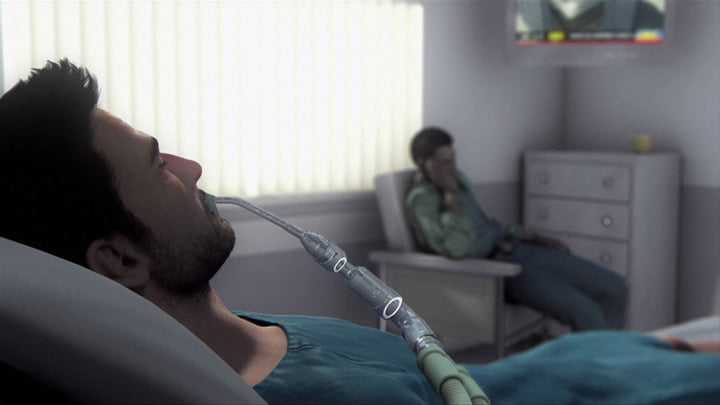
The unfortunate reality of games culture is that critics rarely revisit marginalised games, and the poor standards of quality for even recent releases shortchange the unnoticed artistic vanguard of the medium. Thus, both the indie avant-garde and the occasional experimental studio game like Driver: San Francisco is often only appreciated in retrospect given this status quo.
Indeed, many critics remain conscript to the idea that a game like The Witness is unequivocal evidence of auteur-driven artistry or that the DOOM reboot is a high watermark for video games and not just a regression to narratively and thematically bankrupt genre comforts. All the while, these same critics (and by extension gamers) become nonentities when the likes of Cardboard Computer’s Neighbor or Delphine Fourneau’s Sacramento quietly emerge into an indifferent games culture despite possessing newfangled ideas of what video games can be and should be about.
A game like Driver: San Francisco may not fall under the arthouse parameters and independent mode of distribution like Neighbor or Sacramento, but like Kane & Lynch 2: Dog Days or Wet, it’s not “accidentally” artful either. This thinking undersells those works, and it undersells video games for lack of examining these games critically, politically, and historically.
If we are to even begin examining Driver: San Francisco through critical, political, and historical lenses, then we must consider what its California setting means for the game, and especially its positioning within San Francisco. The comatose detective John Tanner dreams up San Francisco, and his ability to shift from car to car to “possess” any driver on the road renders him a kind of floating spirit above the skies of California. Since he can shift to any potential non-player character (NPC) on the road, Driver: San Francisco allows players to essentially inhabit the role of San Francisco itself.
Every single character can be embodied, and the definition of “Driver” becomes universal: anyone on the road is a Driver, capable of starring in their own story. That Driver: San Francisco identifies a particular, real-world sense of place is crucial to the story because video games infrequently invoke local cultures and myths, and these elements bring personality and good humour to the proceedings.
And what is San Francisco? The game renders this city with an eye for its singular culture and history, incorporating numerous Asian-American characters befitting the area’s significant diaspora. The body-shifting mechanics of the game gesture towards common LGBTQ themes like the fluidity of identity and body politics, reflecting the prolific queer art scenes from neighbourhoods like The Castro, The Mission, or Haight-Ashbury. Furthermore, Driver: San Francisco’s numerous car chases that spill down the sloped streets of the city evoke comparable sequences in the iconic San Francisco car movie Bullitt. Even more commendably, the game taps into certain myths surrounding the city and California itself, weaving such ideas within its dreamlike narrative.
This isn’t just San Francisco as a perfunctory backdrop; this is Joan Didion’s San Francisco and the myths of California, a land of “some dreamers of the golden dream” and “reinvention, in which we escape the past to find ourselves.” It’s also Alfred Hitchcock’s dreamlike San Francisco camouflaged in broad daylight and spiralling into a lost history, where characters “wander together, pursuing the past and running, with all deliberate speed, from themselves.” Driver: San Francisco encapsulates these paradoxical ideas, locating characters repressing past trauma but somehow colliding straight into it (escaping the past, pursuing the past), evading realities through dreams only to dig deeper at the truth.
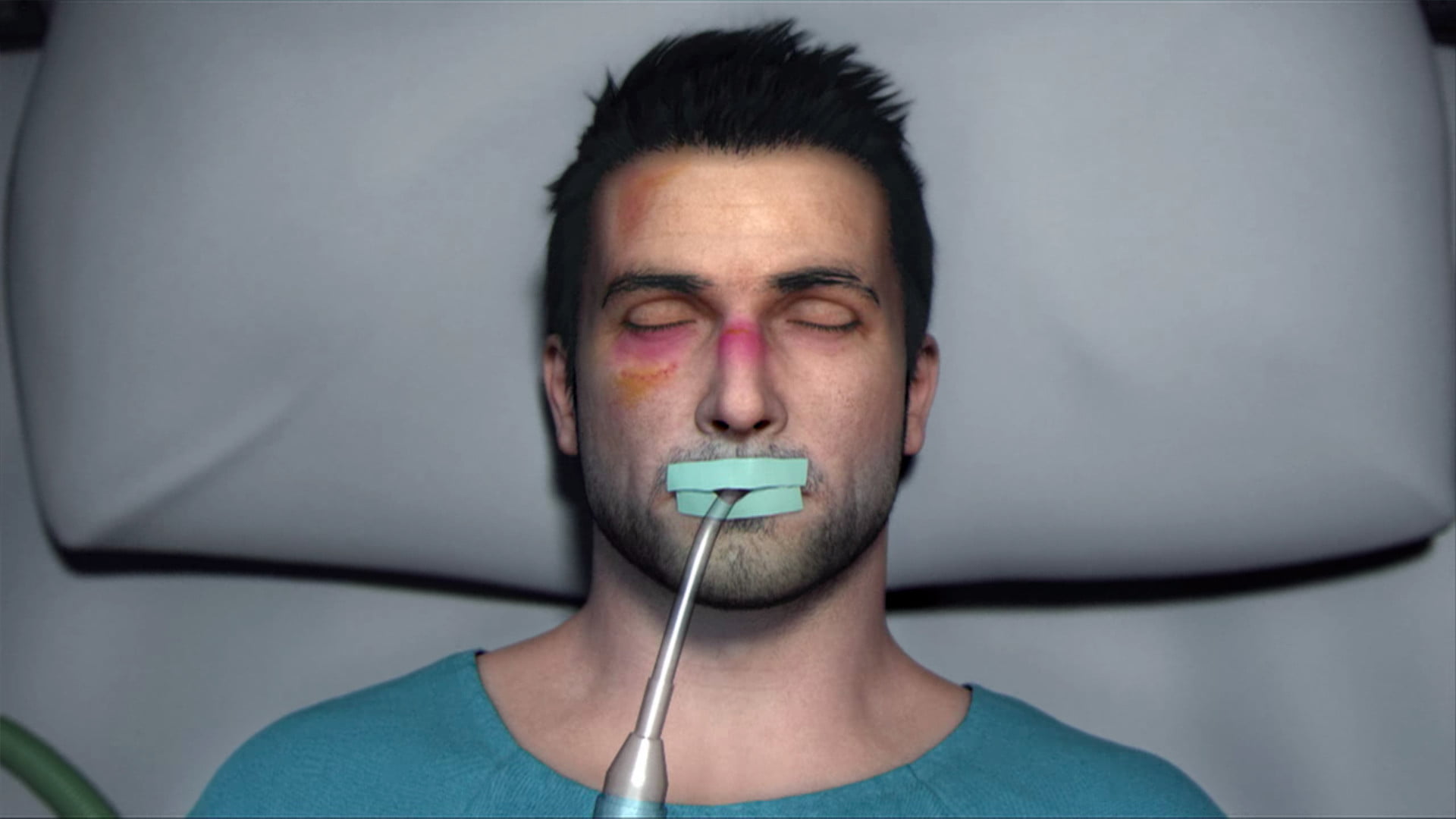
Like the sunny, West Coast sprawl of Crazy Taxi, Driver: San Francisco entwines mundane moments within its truth-seeking tale of Californian dreaming. As Tanner shifts from his body to many other drivers on the road, we’re treated to countless slices of everyday life in San Francisco with individual micronarratives taking place inside each car. While occupying the driver’s seat in some stranger’s car, Tanner will joyously embody an older cop reassuring a rookie, a spouse renting a sportscar to impress friends at a reunion party, or an old grandmother recklessly tearing through the hills of San Francisco.
Tanner falls into the bizarre milieus he encounters, unquestioningly performing the role he shifts into with goofy play-acting and dumbfounded amusement. His curiosity about the lives of the passengers he enters carries a humorous, voyeuristic quality like he’s watching a soap opera unfold, as in one scene where he converses with a woman while oblivious of their relationship only to find out she’s having an affair (he exaggerates his reaction).
Tanner often finds himself possessing meek characters, and he responds by infusing a dose of confidence and flair into their behaviour, speech, and driving ability, thus surprising their passengers and improving their lives.
Refreshingly, Driver: San Francisco is a good-humoured, upbeat video game, devoid of the cynicism that frequently bogs down crime storytelling in the medium. Beyond the funky, psychedelic soundtrack and a warm, sunlit aesthetic conveying good vibes, Driver: San Francisco radiates positivity by simply foregrounding the act of helping other people. At one point, Tanner notes to himself, “The more people I help, the stronger I get,” revealing the benevolent heart at the crux of the game.
By helping others (almost all complete strangers), Tanner accesses the incidental yet lively microcosms of car culture in San Francisco that would otherwise be overlooked in another game about simply defeating “the bad guy.” For instance, Tanner will recurrently shift into the driver’s seat of two young Japanese teens engaged in illegal street racing, learning of their desperation in earning college tuition money and eventually sharing in their exhilaration after winning their first race.
In another scene, Tanner will embody a disgruntled traffic cop tired of conducting monotonous paperwork, relaying to his partner of his desire to become a vigilante and curtail organised crime. This being Tanner’s comatose reality, he acquiesces to such flights of fancy, orchestrating fictional wish-fulfilment with glee. But since none of this is real—which the game regularly reminds us—what would be the point of aiding these hallucinatory phantasms and chasing down the game’s big baddie Charles Jericho? For Tanner, such acts of Good Samaritanism simply feel good.
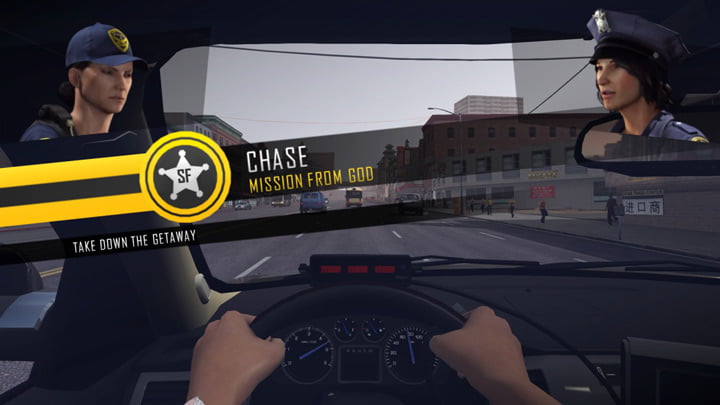
John Tanner masterminds hypothetical police work in his mind, battling the anxieties buried within his consciousness and turning the petty criminal Jericho into a larger-than-life, unconquerable mythical figure obeying bizarre dream logic. Driver: San Francisco shares kinship with the circuitous works of writer/director Charlie Kaufman, evoking the loopy dream structure of the movie Being John Malkovich and visualising the absurdist campaign of fighting back against one’s own dream like Eternal Sunshine of the Spotless Mind.
Tanner isn’t battling Jericho but a mental projection of his own making; he imbues the antagonist with his own fears, rendering him fantastical and irrepressible. Jericho’s master plan to construct a massive homemade bomb confuses the naïve Tanner, (rightly) believing him to be a two-bit gangster and not an international terrorist. Indeed, the Jericho of Tanner’s dream is partly constructed by the nonstop news reports on the television overhead in the hospital room, its audio unconsciously seeping into his mind. Distant bomb threats on the world news become realities on the streets of San Francisco, and he obsessively sees Jericho in other drivers that aren’t him.
Driver: San Francisco is a game about a dreamer in San Francisco, where people are possessed and its protagonist wanders around as if in hypnosis, eerily recalling the oneiric story of Alfred Hitchcock’s Vertigo. Like James Stewart’s character in the 1958 film, Tanner must reenact his traumatic accident briefly seen in the beginning of the story in order to overcome that fear and rouse himself from dreamlike inertia.
Jericho’s antagonistic struggle suggests an unconscious defence mechanism preventing Tanner from accessing his unsavoury repressed memory that he’s dying on a hospital bed. He chases after “dream” girls much like Kim Novak’s illusory doppelgänger in Vertigo, tailing cars through the streets of San Francisco and duplicating James Stewart’s actions throughout that movie. In addition to Vertigo, the game also owes some imagery to Hitchcock’s The Birds, depicting a murder of crows stalking Tanner throughout his travails. These crows, along with the They Live-esque billboards communicating short messages from the real world, serve as narrative ruptures that threaten to break apart Tanner’s fragile dream.
Even shifting from car to car suggests the fragmentary quality of dreams as Tanner plummets mid-conversation in a stranger’s car and leaves at random, mirroring dream logic’s lack of context and closure. Moreover, the paused map screen depicts his surreal dream state, overlaying the map with an iris effect as though a giant eye is looming over San Francisco, and the heart rate monitor is also superimposed to remind players of the unreal setup.
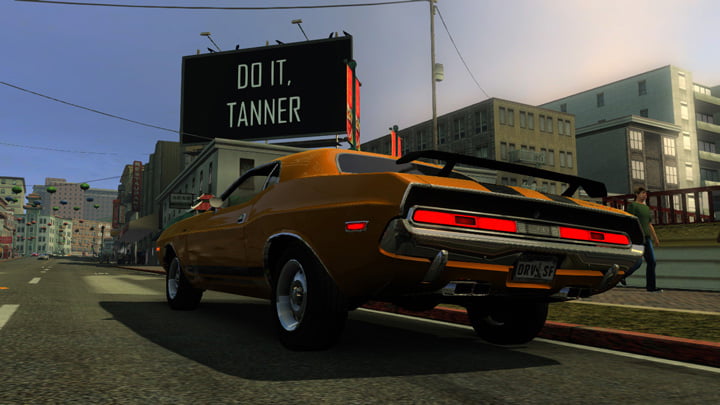
During moments when Tanner’s dream collapses – when his partner Tobias Jones communicates to him from the real world via a muffled car radio or when Tanner runs into invisible walls that directly signal the borders of his dream’s reality – Driver: San Francisco pushes abstract ideas that toy with the conventions of video game storytelling.
Since this game is about a man literally controlling other bodies, Tanner is essentially playing a large-scale video game within his head; he dreams of video games. After completing a few races with the aforementioned pair of teenagers, the passenger calls you “John” instead of his friend’s real name Jun, and Tanner confronts a slip in reality. If Tanner is manipulating other bodies, then he’s playing his own racing game when he shifts into the car of the teenage street racers, and this slip of the tongue represents a break in the fourth wall. The friend acknowledges that Tanner is controlling the driver, breaking his immersion.
Driver: San Francisco is willing to follow through with such offbeat images and themes, like in a trippy sequence that witnesses the entire city frozen in what Tanner calls a “nightmare remix of San Francisco.” He must chase after a ghostly ambulance racing by in slow motion, and traffic disappears upon crashing into it.
The most daringly metafictional and bizarre sequence in Driver: San Francisco occurs when Tanner – who has his consciousness shifted into an enemy driver – encounters his own car that contains his physical body and his partner. The sequence is a wild out-of-body experience and abstraction of gameplay wherein Tanner must drive the car containing his body and his partner remotely from the seat of the possessed driver. Thus, players simultaneously control both the encountered car in third-person perspective and Tanner’s consciousness in first-person perspective in order to avoid the suspicion of an antagonist.
The gameplay is inelegant and strange; you play as a character controlling another character through a windshield that acts like a televisual screen, reinforcing the idea that Tanner is playing a kind of video game. In another unorthodox sequence, Jericho possesses Tanner’s empty physical body while your consciousness is locked in your partner Jones’s. Suddenly, you no longer play the position of someone driving, but instead serve as a passive spectator, stripping away interactivity and bending the rules of conventional gameplay.
Interestingly, Ubisoft was invested in daring ideas of memory, consciousness, dreams, and characters in limbo states not only in Driver: San Francisco but also in another under-appreciated 2011 game, Assassin’s Creed: Revelations. We can learn much in a comparative examination of the two works in the future, identifying how characters in each are caught in a mental purgatory and must traverse through dreamlike memories to escape.
But perhaps the closest analogue to this game is Burnout Paradise, another racing game revolving around an empty metropolis. Here, Paradise depicts a depopulated dream state where buildings seem to exist for no visible people and the only human presence is in the disembodied voice of the radio DJ like some kind of omniscient god. Driver: San Francisco stretches the parameters of video game logic directly into the realm of the dream, and the results are as playful as it is formally odd, constantly surprising, and pleasingly charming.
At the end of the game, when Tanner inevitably returns to his waking life in the real world, the illusory smokescreen is suddenly lifted. Cars cannot boost because there’s no such thing as boost, and Jericho is not a mythic criminal but is harmlessly dispatched in an anticlimactic showdown. In identifying the mundaneness of reality, Driver: San Francisco underlines the significance of creativity and imagination.
To live in California is to dream, and the dream is always more remarkable.




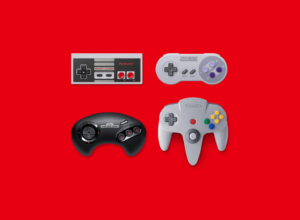


There’s no other racing game like this.’
Yeah, Forza, The Crew Wild Run and other dominant racing games today may have more content than this but this has a soul that sticks out more than others.
– An awesome driving physics system that balances arcade and simulation so beautifully.
– A nice range of vehicles despite no customization, every car handles differently enough to make me forget about what body kit it needs.
– As it says in this fellow’s article, it does live up to the game’s title, many gameplay elements that many other today’s racing games should have like the games had in the late 90s (Gran Turismo 1,2 NFS Hot Pursuit and High Stakes games and many Rally games) to the early 2000s (Gran Turismo 3, 4, any NFS made by Black Box Studios, Juiced 1, etc. etc.)
This comment would be as long as this article if I describe how I feel about this game because it’s such a satisfying game.